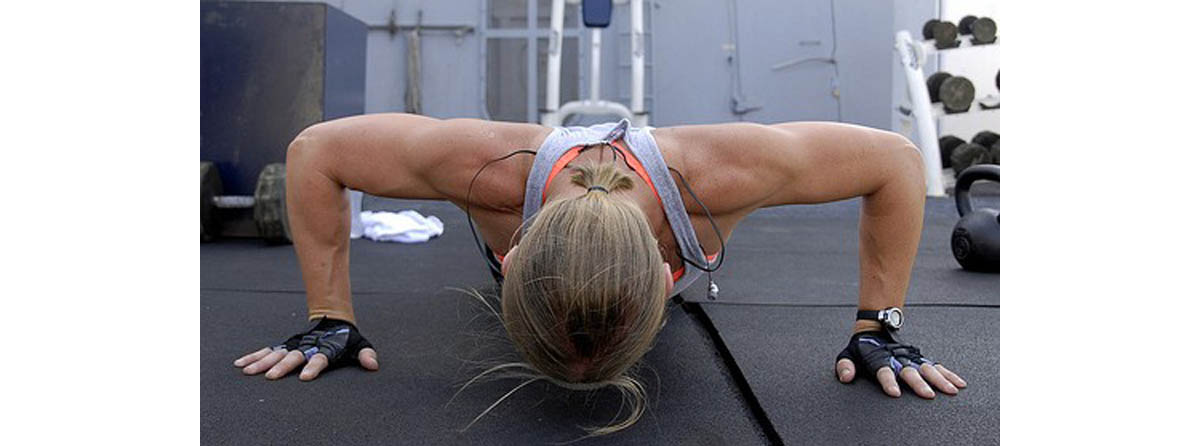Table of Contents
All three common mistakes are essentially a way to avoid doing a push-up by doing something else instead. It’s a better idea to simply learn to do push-ups, and here’s a progression of simple bodyweight exercises that end in a set of picture-perfect pushups.

1: The Plank
Planks are a go-to abs exercise – in fact, though, many people go to them far too much. After about 1 minute, is a prolonged static hold really doing you any good? After all, the job of the core is to stabilize dynamically - against constantly changing forces.
If you can’t hold a plank, then your push-up form will suffer, though, so start with the simpler exercise. To perform a basic plank, start with your elbows under your shoulders and your hands together, your forearms forming an inverted V shape. Your feet can be shoulder-width apart – put them together to make the exercise harder. Keep your body in a straight line from the heels of your feet to the crown of your head. That’s it – except it’s not…
2: The Advanced Plank
The advanced plank is performed by simply doing a normal plank extremely well. It’s a general rule of bodyweight training that minor progressions in form make massive changes to the difficulty of an exercise and this is no exception.
Begin by getting into your standard plank position. Now, walk your elbows forward and narrow them as much as you can. Tense your quads (the muscles in your thighs) to lock your legs out and tense your glutes as hard as you can, which will throw more stress onto your abdominal muscles and protect your lower back more too. Keep your neck in a neutral position.
Essentially you’re increasing the ‘calliper-like’ forces on the body, and at the same time making the body less of a calliper shape and more like a plank. That means more force and less leverage, making the exercise that much harder.
3: Static Holds
What it says on the tin. This is a push-up where you start in the top position and stay there. Concentrate on your core alignment and hold for a maximum of a minute before moving on to another progression.
4: Half-Hindu Push-ups
These don’t require you to make a half-hearted religious commitment. Rather, they are an adapted Hindu push-up – a great exercise in its own right – altered to make it more effective at improving your push-up.
Begin in the standard push-up position, and lower yourself to the bottom position. Then pull your butt back and up without bending your knees – it’s OK to bend them slightly but your legs should stay more or less straight. You should finish in the yoga position called ‘downward dog’ – an inverted V shape with your hips high and your arms and legs straight. Lower yourself to the top of the push-up position and repeat. While standard Hindu push-ups are a good push-up progression in themselves, these can be better for learning push-ups, since the downward movement is a negative push-up.
5: Push-ups
Set up with your neck in neutral, your glutes and abs fired up and your chest large, looking at a spot on the floor a few feet in front of you. Making sure the heads of your shoulders stay in place and your arms don't 'screw' or twist, lower yourself until your chest, hips and chin just kiss the ground together. For individuals with larger chests, the chest should be the guide, and there shouldn't be any weight on the chest. Drive back up. Don't allow your shoulders to creep forward - your scapulae will move naturally but don't use the upper deltoids too much. This should be an upper back as much as a chest exercise.
Pointers for the way forward
A couple of sets of good push-ups are beyond most people who consider themselves fit. If you found 2X20 a doddle or you’re looking for the next step, try these tweaks.
Monkey with the tempo. When you alter the rate at which you do an exercise you alter the exercise. Deadlift fast enough and it runs the risk of becoming a clean pull. Front squat too fast and you might squat press by accident! Push-ups can be made more of an effective strength exercise by doing the negative – the lowering part – very slow. Try counting five on the way back down, holding the bottom position for a second and coming back up as fast as you can. If five’s easy, try ten.
Alter the range of motion. Try elevating your hands, so that you can lower your body through your hands and get a ‘deeper’ push-up. Even an extra inch of travel can make a huge difference to your push-up’s effectiveness.
Take something off the floor. Taking a foot off the floor makes the stabilization demands on the core much harder, which in turn challenges your chest and shoulders that much more. If you feel like a real challenge try taking one hand off the floor…
- Photo courtesy of U.S. Air Force photo/Airman 1st Class Grace Lee by Wikimedia Commons : commons.wikimedia.org/wiki/File:Airman_doing_pushup.JPG
- Photo courtesy of Naval Surface Warriors by Flickr : www.flickr.com/photos/navalsurfaceforces/7839560902/

